Bojnická Jeskyne
Prepostska Jaskyna - Bojnice Castle’s Cave
Useful Information
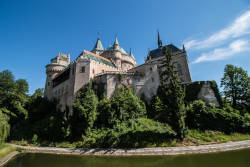
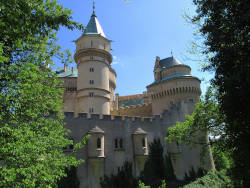
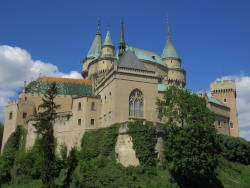
| Location: | Bojnice, Priedvidza. Below Weinitz Castle. |
| Open: |
JAN to MAY Tue-Sun 10-12, 12:30-15. JUN Tue-Sun 10-12, 12:30-16. JUL to SEP daily 9-12, 12:30-17. OCT to DEC Tue-Sun 10-12, 12:30-15. Closed 01-JAN, 24-DEC, 25-DEC. [2021] |
| Fee: |
The Castle Tour:
Adults EUR 11, Children (6-15) EUR 4.50, Children (3-5) EUR 1.50, Children (0-2) free, Students (-26) EUR 7, Seniors (65+) EUR 8, Disabled EUR 6. The Gallery Tour: Adults EUR 11, Children (6-15) EUR 4.50, Children (3-5) EUR 1.50, Children (0-2) free, Students (-26) EUR 7, Seniors (65+) EUR 8, Disabled EUR 6. Both Tours: Adults EUR 15, Children (6-15) EUR 5.50, Children (3-5) EUR 1.50, Children (0-2) free, Students (-26) EUR 9, Seniors (65+) EUR 10, Disabled EUR 7. [2021] |
| Classification: |
 Tufa cave Tufa cave
|
| Light: |
 Electric Light Electric Light
|
| Dimension: | Ø=22 m, VR=26 m, H=6 m. |
| Guided tours: | D=75 min, Min=15, Max=50. V=400,000/a. |
| Photography: | yes, photo and video permit available at ticket office |
| Accessibility: | no |
| Bibliography: | |
| Address: |
SNM - Múzeum Bojnice, Zámok a okolie 1, 97201 Bojnice, Tel: +421-46-5430-624, +421-46-5430-633.
E-mail: |
| As far as we know this information was accurate when it was published (see years in brackets), but may have changed since then. Please check rates and details directly with the companies in question if you need more recent info. |
|
History
| 1113 | first written mention of Bojnice castle in the Zobor Abbey scrolls. |
| 13th century | transformed into a stone castle. |
| 16th century | castle expanded by two additional wings. |
| 1644 | baroque make-over by the Pálffy family. |
| 1888 | cave restored and existence of the cave became public known. |
| 1889 to 1910 | extensive neo-gothic renovation. |
| 1907 | castle opened to the public. |
| 1950 | castle opened to the public, run by the Nitrianske County Museum. |
| 1967 | cave opened to the public. |
| 1970 | castle declared a National Cultural Monument. |
Description
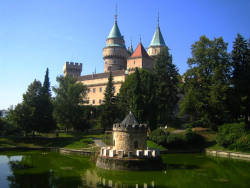
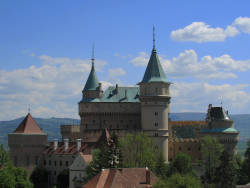
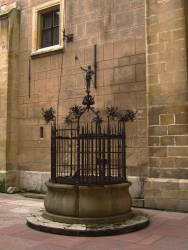
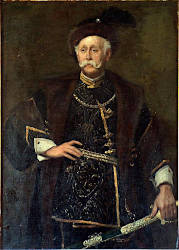
Bojnická Jeskyne is a castle cave, which means it is located below Bojnicky Zámok (Bojnice Castle) and integral part of the building. If you want to visit the cave you have to visit the castle, and you will get a castle and cave trip including ghost stories.
The original castle which existed in the 12th century was a wooden fort standing on a travertine hill. The first written mention of the castle is from 1113 in a document of the Zobor Abbey. Probably there was even an earlier fortification. During the 13th century the owners, the Poznanovec family, continually transformed it into a stone castle. At the end of this century the Hungarian nobleman Matúš Čák Trenčiansky seized Bojnice and subsequently owned it until 1321. During the 14th and 15th centuries it was owned by several aristocratic families, the Gilethovci, Leustachovci, and Noffryovci. The owners were changing quite frequently. In 1489 King Matej Korvín donated the castle to his illegitimate son Ján Korvín. But after his death was seized by the troops of Zápoľský who owned it until 1526. In 1527 it was donated to Alexei Turz by King Ferdinand I. He was responsible for the renovation and transformation into a comfortable Renaissance mansion. In the 16th century the castle was expanded by two additional wings.
With the extinction of the Turz family in 1636 the castle was again property of the crown. In 1637 the Hungarian nobleman Pavel Pálffy lent 200,000 gold pieces to the Emperor Ferdinand III who gave him the Bojnice estate as a deposit. It seems he had problems with paying back and in 1643 the Pálfi family received the Bojnice castle as hereditary possession. In 1644 Bojnice was given a baroque make-over by the current owner. The last noble owner of the castle, Count Ján František Pálfi (*1829-✝1908) took ownership in 1852. He hired Austrian architects in 1888, to rebuild the castle into a romantic chateau, inspired by the French Gothic castles of the Loire Valley. This resulted in the look of the castle we it see today.
During the last renovation of the castle the cave below the castle was discovered.
The castle stands on a travertine hill.
Travertine is a rather soft sort of limestone, formed very recent (in geologic terms) by precipitation from limestone saturated spring water.
This process also produces caves by enclosing spaces through irregular growth of the limestone deposits.
The cave is a
 tufa cave, which is a primary cave, a cave formed together with the surrounding rocks.
The cave is more or less a single circular chamber, 26 m below the level of the fourth courtyard from which the castle well descends into the cave.
It is 22 m in diameter and is 6 m high.
Two ponds in the cave are probably connected to other caves in this area.
tufa cave, which is a primary cave, a cave formed together with the surrounding rocks.
The cave is more or less a single circular chamber, 26 m below the level of the fourth courtyard from which the castle well descends into the cave.
It is 22 m in diameter and is 6 m high.
Two ponds in the cave are probably connected to other caves in this area.
There must have been a spring producing the water which formed the travertine. Most likely it was inside the cave, or see it this way: the cave is the former spring. The still existing spring was a wealth of the castle, an internal source of drinking water which could not be polluted by enemies. The water may be called mineral water, there are rumours that it once was a thermal spring.
There is archaeological evidence that the cave was used during the Stone Age.
Today Bojnice is a famous spa, and the castle is famous day trip destination. There are similarities to the architecture of Neuschwanstein in Germany, and of course to the castle at Disney World. The castle is open to the public, today there is a museum and a hotel in the castle.
 Search DuckDuckGo for "Bojnice cave"
Search DuckDuckGo for "Bojnice cave" Google Earth Placemark
Google Earth Placemark Bojnice Castle, official homepage. (
Bojnice Castle, official homepage. (

 )
) Index
Index Topics
Topics Hierarchical
Hierarchical Countries
Countries Maps
Maps